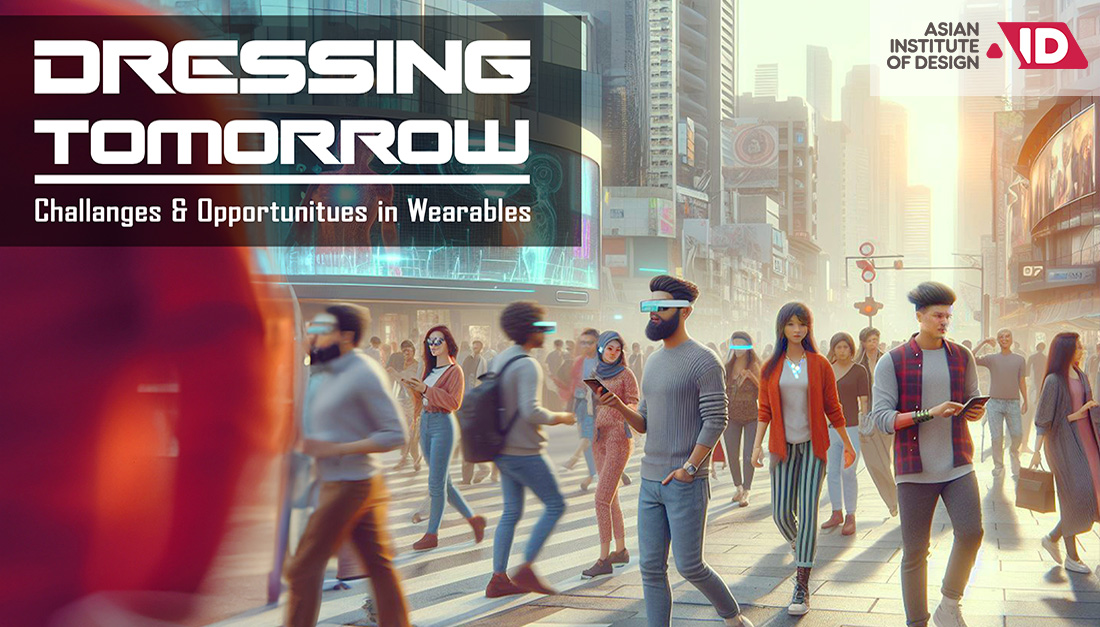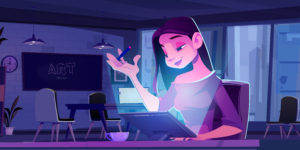Embracing Tomorrow: The Future of Wearable Technology Design

Introduction:
Wearable technology, once a novelty, has seamlessly integrated into our daily lives, evolving
beyond mere gadgets to become indispensable accessories. From fitness trackers to
smartwatches, the fusion of fashion and technology has birthed a dynamic field with boundless
potential. In this exploration, we delve into the challenges and opportunities that designers
encounter as they shape the future of wearable technology. Our journey will navigate the delicate
balance between aesthetics and functionality, unravel the intricacies of data security and user
interface, and marvel at the exciting convergence of fashion and technology through innovative
examples.
Challenges in Designing Wearable Technology:
1. Form Factor vs. Functionality:
Designing wearable technology is the art of finding harmony between aesthetics and
functionality. Users demand sleek, stylish designs without compromising the capabilities of the
device. Striking this delicate balance poses a constant challenge for designers aiming to create
products that seamlessly integrate into users' lives.
2. Battery Life and Power Efficiency:
The limited space for batteries in wearables poses a perpetual challenge. Designers must
constantly explore power-efficient technologies and innovative charging solutions to extend
battery life, ensuring a seamless user experience without sacrificing the device's capabilities.
3. Data Security and Privacy:
As wearables collect sensitive personal data, concerns about privacy and security arise.
Designers are tasked with implementing robust security measures to protect user information,
ensuring trust and confidentiality in an era where data breaches are prevalent.
4. User Interface and Experience:
The compact physical space on wearables demands intuitive and user-friendly interfaces.
Designers focus on creating seamless interactions to enhance the overall user experience,
navigating the challenge of providing functionality within limited real estate.
Technology:
1. Customization and Personalization:
Wearable technology opens doors to personalized designs that cater to individual preferences.
Designers can explore customization options, incorporating fashion elements that resonate with
users' unique styles, creating a more intimate connection between the wearer and the device.
2. Fashion-Tech Collaborations:
Collaborations between fashion designers and tech companies are fertile ground for innovation.
The synergy between fashion aesthetics and technological prowess results in wearables that
transcend mere functionality, appealing to a broader audience with their stylish designs and
cutting-edge features.
3. Invisible Technology:
Advancements in material science allow for the integration of technology into everyday clothing
and accessories without sacrificing style. The future of wearable tech might witness the rise of
"invisible" technology seamlessly woven into fabrics, blurring the lines between fashion and
function.
4. Health and Wellness Integration:
Wearable devices play a pivotal role in monitoring health and wellness. Designers have the
opportunity to create products that not only track health metrics but do so with a fashion-forward
approach, seamlessly blending technology with the user's lifestyle.
Showcasing Innovative Examples:
1. Google Jacquard:
The collaboration between Google and Levi's resulted in a smart jacket with conductive threads,
enabling users to control their devices with simple gestures. This exemplifies the seamless
integration of technology into everyday clothing, a step towards a more interconnected future.
2. Apple Watch Hermès:
Apple's collaboration with the luxury brand Hermès produced a collection of stylish bands and
watch faces, showcasing the marriage of cutting-edge technology with high-end fashion. This
partnership sets a precedent for wearables that are both functional and fashionable.
3. Project Jacquard by Samsung:
Samsung's Project Jacquard explores the incorporation of flexible displays into clothing, creating
a seamless blend of technology and fashion. This ambitious project pushes the boundaries of
wearable technology, envisioning a future where our garments become interactive displays.
4. Ringly:
Ringly offers smart jewelry that discreetly notifies users of important calls and messages. This
example proves that fashion and functionality can coexist harmoniously, catering to users who
seek both style and practicality in their wearables.
Conclusion:
As wearable technology continues to evolve, designers stand at the forefront, facing both
challenges and opportunities in shaping its future. The intersection of fashion and technology
holds immense potential, offering a playground for creativity where products not only enhance
our daily lives but also make a distinct style statement. By addressing challenges head-on and
embracing collaborative creativity, designers can propel the field of wearable technology into an
exciting and stylish future. The journey towards seamlessly integrating technology into our
wardrobes has only just begun, and the possibilities are as limitless as the human imagination. In
the marriage of fashion and technology, we find not only functionality but a canvas for self-
expression and innovation.
Similar Articles
-

Mastering 2D and 3D Animation 03-04-2025
The Ultimate Career Boost in Today’s Creative Industry The demand fo
-

How to Make a Graphic Design Portfolio? 02-27-2025
Imagine walking into a room full of potential clients or employers, bu
-

What are the 12 Principles of Animation? 02-27-2025
Animation is more than just moving images—it’s the art of brea
-

The Changing Face of the Animation Industry 02-27-2025
The animation industry has undergone a seismic transformation over the
